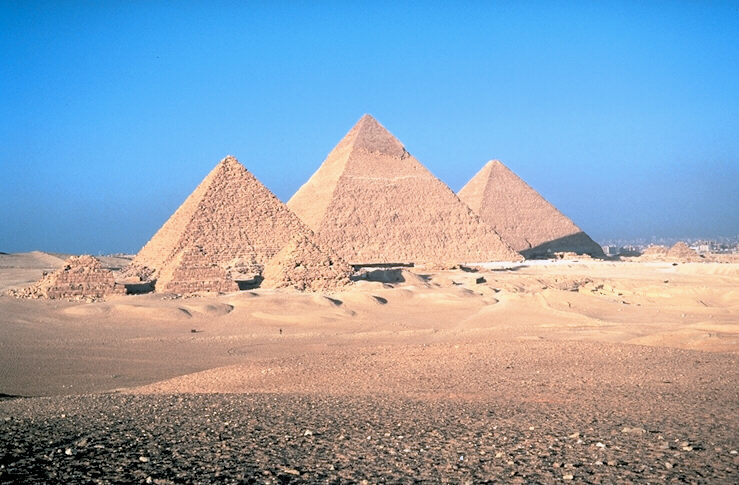Center of mass
 As we saw in the previous problem, whomever worked on the pyramid moved a tremendous amount of stone from the quarries. Let's ignore the effort it took to get the stone from the quarry to the pyramid site, since we don't know the distance, how far they could travel by water vs. cart, etc. and just look at how much effort it took to lift that mass off the ground. To answer this question, we need to know the height of the center of mass of a uniform pyramid with the dimensions of the great pyramid: 150 m high and 230 m on a side. For such a pyramid, how high off the ground is the center of mass
in m
?
As we saw in the previous problem, whomever worked on the pyramid moved a tremendous amount of stone from the quarries. Let's ignore the effort it took to get the stone from the quarry to the pyramid site, since we don't know the distance, how far they could travel by water vs. cart, etc. and just look at how much effort it took to lift that mass off the ground. To answer this question, we need to know the height of the center of mass of a uniform pyramid with the dimensions of the great pyramid: 150 m high and 230 m on a side. For such a pyramid, how high off the ground is the center of mass
in m
?
The answer is 37.5.
This section requires Javascript.
You are seeing this because something didn't load right. We suggest you, (a) try
refreshing the page, (b) enabling javascript if it is disabled on your browser and,
finally, (c)
loading the
non-javascript version of this page
. We're sorry about the hassle.
2 solutions
Prove that the formula that you found in a book is correct
Log in to reply
Check out the derivation here:
http://farside.ph.utexas.edu/teaching/301/lectures/node102.html
It's called Commanido's theorem, right?
How can you work out where the centroid is located?
i think answer is 75
I recognise that there is a standard result I could have just googled but I'm learning a bunch of mechanics stuff at the moment about moments of inertia and there is a lot of similarity in the calculus treatment that can be given to the problem. I find it quite satisfying ;) I do apologise for the lack of diagrams but I have no software to work with here, I will do my best to describe!
First, symmetry tells us that the centre of mass is on the altitude line from peak to base of the pyramid, so that eliminates two dimensions and leaves us with just the height dimension. Imagine cutting the pyramid into infinitesimally thin slices, in a plane parallel to the base - then it becomes a problem of finding the centre of mass of an infinite number of points (since the centre of mass of each slice is the intersection of the two diagonals, which lies on the pyramid's altitude line), which is solved by integration.
Take a cross-section straight down the middle of the pyramid, in a plane perpendicular to the base that intersects the base parallel to one of the base edges. This is a triangle with height h = 1 5 0 and base length a = 2 3 0 . Laying this on an x-y coordinate system with the peak at the origin, and its altitude on the x-axis, we obtain the function ∣ y ∣ = 2 h a x . The bottom part is unnecessary, so just consider y = 2 h a x
Remembering that the side-length of an infinitesimal slice through the pyramid is 2 y on this graph, we can find the volume δ V of the slice, thickness d x :
δ V = ( 2 y ) 2 d x = h 2 a 2 x 2 d x
The total volume of the pyramid could be taken as the integral over x ∈ [ 0 , h ] , but the standard result is easily remembered as V = 3 1 a 2 h . Then the volume density, ρ , of the pyramid is found:
ρ = V M = a 2 3 M h
The mass of our infinitesimal slice is calculated:
δ m = ρ δ V = h 3 3 M x 2 d x
The perpendicular distance of the centre of mass from the base is denoted by x . Since for convenience the top of the pyramid is at the origin, observe the adjustment in the centre of mass formula:
( h − x ) M = ∫ 0 h x δ m = ∫ 0 h h 3 3 M x 3 d x = 4 3 M h
Solving obtains x = 4 1 h , and substituting the value of h gives the final answer of x = 3 7 . 5 m
Brilliant! Love a creative solution.
For a solid cone or pyramid, the centroid is 4 1 × the distance from the base to the apex.
Since the pyramid was 1 5 0 m high, the centre of mass is 4 1 5 0 m high.
⇒ The centre of mass is 3 7 . 5 m high from the ground.